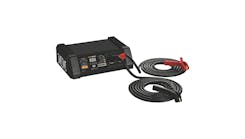Occasionally, we all get one of those vehicles that throws a curveball at us. When this happens, the best way to deal with it is to take a breath, step back for a moment, and reassess the situation. Think logically, decide what piece of information you need to know, and then jump back in with the additional test to find your answer. This will help avoid a wild goose chase or going down the proverbial rabbit hole. This is one of those situations where I almost made the wrong call, stepped back to scratch my head, and jumped right back in with the extra tests needed to be completely accurate with my diagnosis.
The vehicle in question is a 2006 Nissan Xterra equipped with a VQ40DE 4.0-liter engine and manual transmission and is rear wheel drive (Figure 1). It was towed into the shop because it had stalled while driving and now exhibits a “crank/no-start” condition. The customer stated that there were no lamps lit up on the dash before this problem occurred. Relatively quickly the technician diagnosed that the timing chain had jumped teeth. A timing chain replacement was approved by the customer and the timing cover was removed. The technician's diagnosis was correct, because none of the plastic from the timing chain guides was existent. The lack of tension allowed the timing chain to jump teeth. This is nothing new to us as technicians. The service advisor sold the job, with all the appropriate extras, and shipped it off to the technician. The technician completed the repair and now the vehicle exhibits new symptoms. First, the vehicle intermittently “runs poorly.” Second, the MIL is illuminated and the ECM has stored two DTCs: P0011 – “INT/V TIM CONT-B1" and P0021 – “INT/V TIM CONT-B2"
Duty calls
At this point, the shop gave me a call. Upon my arrival, I started my diagnosis as I quite often do —with a scan tool. I confirmed that the DTCs previously mentioned were present and that they were the only codes stored in the ECM. Next, I observed live data with the engine running. The camshaft data PIDs suggested that both camshafts were retarded 15 crankshaft degrees while both VVT solenoids had command of zero percent. I was beginning to believe that the timing chain had been installed incorrectly. However, I had to question myself because I believe that the technician is skilled and competent. I also know that the shop has access to the correct service information, that I am told was followed exactly, and the technician swears the timing marks were lined up correctly. Time to move on with more testing.
My first scope test was to perform a relative compression test. I chose this test not because I was concerned about the compression of the engine but the general ignition timing. In the capture (Figure 2) you can see that the ignition trigger signal (gold) occurs just before the top dead center of the relative compression (purple) trace and does not appear to be an issue. (Note: this ignition timing test is only a ballpark measurement.) The next test to be performed is a CKP/CMP sensor correlation.
If we are to compare CKP and CMP sensor signal synchronization we will need a known good example. Most manufacturers do not provide this in service information. However, Nissan is one of the manufacturers that do (although it is an illustration and not an actual scope capture). In my database, I happened to have a known good capture from an extremely low milage 2005 VQ40DE that I captured a few years back. It has all the information that we need to perform this analysis (Figure 3).
Using the known good capture, I found a place to compare all three signals that would be easy on the eyes and then used that point to make a comparison. I made the same connections to the broken vehicle, obtained the capture, and proceeded with the analysis (Figure 4). I performed some measurements and confirmed that both CMP sensor signals were retarded approximately 17 degrees in relation to the CKP sensor signal.
In this test, the 15 degrees of camshaft retard reported by the scan tool, and what appears to be normal ignition timing, is still suggesting improper timing chain installation. I need to know before I tell the shop to remove the timing cover again “just to check,” so I move forward. Luckily, when I took my known-good capture, of the low-milage 2005 Frontier, I had installed a pressure transducer in one of the cylinders. I decided to dig a little deeper and use the information I had gathered previously to make some more comparisons. First, I wanted to know a more accurate ignition timing measurement.
The ignition timing from the known-good capture measures to be 13 degrees advanced (Figure 5). The procedure was repeated on the broken vehicle and the measurement came out to be 39 degrees advanced (Figure 6). This seemed a bit odd to me because usually when ignition timing is off on a modern vehicle it is retarded. Either way, ignition timing is dictated by the CKP sensors input to the ECM and I think a closer look at the CKP is in my future.
Second, I wanted to know how the CKP sensor signal lined up with top dead center. Using the same captures, with a little different zoom, I made this comparison. The known good capture shows the top dead center lining up with the rising edge of the last CKP pulse before a large gap (Figure 7). In the bad capture, the CKP sensor signal has moved to the left, indicating that it is advanced (Figure 8). More measurements are performed and a difference of 19 degrees is observed. At this point, I am thinking that the timing chain is not the issue, but is there another test we can perform to definitively take incorrect timing chain installation off the table?
Using the same captures already obtained we can make another comparison: verification of camshaft timing by observing valve events in the in-cylinder capture. Since this vehicle is of a single overhead camshaft design, I opted to measure the timing of the opening of the exhaust valve since it is relatively easy to pick out. On the known good capture, the exhaust valve opening (or “EVO” is occurring) at approximately 36 degrees before bottom dead center (Figure 9). On the broken vehicle EVO is occurring at approximately 38 degrees BBDC (Figure 10). I am not going to sweat two degrees and am now totally confident that the timing chain installation is not the issue. Now it is time to investigate the CKP sensor reluctor.
Following the clues
The CKP sensor on this vehicle is located at the back of the engine and its reluctor is on the flywheel. I inform the shop that the transmission is going to have to come out to confirm what is going on with the reluctor and subsequently repair the vehicle. Upon removal, it is noted that there is a locating pin on the rear of the crankshaft (Figure 11). This locating pin’s purpose is to facilitate correct flywheel alignment. However, the forward face of the flywheel has five possible locations for the locating pin to fit into (Figure 12). This means that the flywheel can be installed randomly in five possible positions of which only one would be correct. This also means that there is a 20 percent chance of being correct if we were to just slap the flywheel into place. So now we get to do some math.
We know, from our previous captures, that there are three large windows in the CKP sensor pulse train for every 360 degrees of crankshaft rotation. This means that a large window occurs every 120 degrees of crankshaft rotation (360 divided by 3 = 120.) We also see that the flywheel is held on by eight evenly spaced bolts. This means if the flywheel were to be rotated one bolt hole it would have moved 45 degrees (360 divided by 8 = 45.) If the flywheel were to be installed three bolt holes off (3 multiplied by 45), the large window in the CKP sensor signal will be changed by 135 degrees. If we think about it, 120 degrees off would work, but that is not where we are. 135 degrees minus 120 degrees = 15 degrees. If I remember correctly, almost all of our scope measurements, and the data PIDs in the scan tool, were all off by 15 to 17 degrees. The flywheel was indeed installed three bolt holes off. Since the CKP reluctor was technically off only 15 degrees, the vehicle still started. If another indexing had been chosen, the vehicle probably would have been a crank-no-start.
The shop removed the transmission, installed the flywheel correctly, and reassembled the vehicle. The issue was resolved, no DTCs returned, and the vehicle ran fine. A later conversation with the customer revealed that a clutch had been replaced about a year ago while living in a different state. This is when the time problem originated. However, the customer was still adamant the there was no MIL illumination up until the point that the engine stalled. This raises two questions:
- Why was there no DTC P0011 or P0021 current before the timing chain gave up the ghost?
- Is the customer lying to us?
Employed logic uncovers the mystery
With a little research into the code set criteria for the P0011 and P0021, I think we can theorize why the customer was probably telling the truth. According to Nissan, there is about a 10-degree window of error before these DTCs will set. This would be the code set threshold. When timing chains stretch, the camshafts retard. If the Xterra was advanced 15 degrees due to the incorrect flywheel installation, the timing chain would only have to be stretched enough to cause a little over 5 degrees of camshaft retard to bring it back into the acceptable range and not set the DTCs. That being said, I believe a stretched timing chain was covering up the flywheel that was incorrectly indexed during the previous clutch repair. When the timing chain and guides finally failed and the camshafts were brought back into time, the ECM caught the 15 degrees of discrepancy that fell outside of the code setting threshold. Of course, this is just an educated guess because I never had access to the vehicle before the failure of the timing chain. Whatever the case is, that’s my story and I’m sticking to it.
Since I am a mobile technician, I rarely get a chance to do follow-up testing on the vehicles I diagnose. In this case, the customer did not need their vehicle back right away, and the shop was more than willing to let me come back to repeat my testing on the repaired vehicle. I scanned the vehicle and confirmed that the camshaft timing PIDs had returned to zero degrees. I also repeated all the DSO captures and the test results matched my known-good captures exactly.
This case study also reinforces an important point: the value of having, or obtaining, known good captures. This particular issue would have been very hard, or at least time-consuming, to find if we did not have the known good data to compare to the broken vehicle. Sure, we could have pulled the timing cover to double check the work, but that would have been a waste of time and money. We could have also searched some databases that may have suggested the issue was the flywheel, but I do not want to remove a transmission just to look, which could potentially be another waste of time and money. The non-intrusive testing I performed did not take very long. It involved just a few scope connections, known good data, and the time to analyze the captures. My point is: when opportunities present themselves that allow you to obtain known good data, take the time to get it. Save the data in an organized fashion so the information can be found quickly next time you need it. You will not regret the time you spend gathering data when the day comes that you need it. Besides, the act of obtaining said data gives you practice with the tooling, makes you faster the next time you have to perform the testing, and makes you a better technician in the long run.



